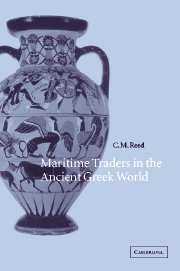Book contents
- Frontmatter
- Contents
- Acknowledgments
- List of abbreviations
- List of references to Greek terms
- Maps
- Introduction
- Chapter 1 Coming to terms
- Chapter 2 Classical modes and patterns of exchange
- Chapter 3 The juridical place of maritime traders
- Chapter 4 The level of wealth of maritime traders
- Chapter 5 Official attitudes towards maritime traders
- Chapter 6 Unofficial attitudes toward maritime traders
- Chapter 7 Archaic modes of exchange and the personnel involved c. 800–475 b.c.
- Chapter 8 Conclusion: then and now
- Appendix 1 Emporoi and nauklēroi: their attested states of origin
- Appendix 2 Cohesion among maritime traders
- Appendix 3 The dikai emporikai
- Appendix 4 Catalogue of emporoi and nauklēroi
- Bibliography
- Index locorum
- General index
Chapter 2 - Classical modes and patterns of exchange
Published online by Cambridge University Press: 22 September 2009
- Frontmatter
- Contents
- Acknowledgments
- List of abbreviations
- List of references to Greek terms
- Maps
- Introduction
- Chapter 1 Coming to terms
- Chapter 2 Classical modes and patterns of exchange
- Chapter 3 The juridical place of maritime traders
- Chapter 4 The level of wealth of maritime traders
- Chapter 5 Official attitudes towards maritime traders
- Chapter 6 Unofficial attitudes toward maritime traders
- Chapter 7 Archaic modes of exchange and the personnel involved c. 800–475 b.c.
- Chapter 8 Conclusion: then and now
- Appendix 1 Emporoi and nauklēroi: their attested states of origin
- Appendix 2 Cohesion among maritime traders
- Appendix 3 The dikai emporikai
- Appendix 4 Catalogue of emporoi and nauklēroi
- Bibliography
- Index locorum
- General index
Summary
INTRODUCTION
Having come to terms with the words emporos and nauklēros in Chapter 1, I ask in this chapter about the principal items carried by maritime traders and how vital these were to the Greek poleis with which they traded. These queries entail four more particular questions: How much of the inter-regional exchange of goods in the classical period was by commerce as distinct from other means of exchange? What proportion of this long-distance trade was in the hands of those, described in Chapter 1, who made it their primary occupation? Even if quantification remains impossible, can we say anything meaningful about the number of maritime traders? And what was the level of demand for the principal commodities traders transported to Greek poleis? A great need on a large scale for imports of certain items might bear directly on the place of traders in the poleis of classical Greece – the subject of Chapters 3–6 and the heart of this book.
Implicit in that last sentence is an important working assumption: since this is a monograph on traders, not on trade, I take up trade only inasmuch as it illumines the place of traders. No attempt is made here to provide an exhaustive account of the modes and patterns of exchange in classical Greece.
- Type
- Chapter
- Information
- Maritime Traders in the Ancient Greek World , pp. 15 - 26Publisher: Cambridge University PressPrint publication year: 2003



